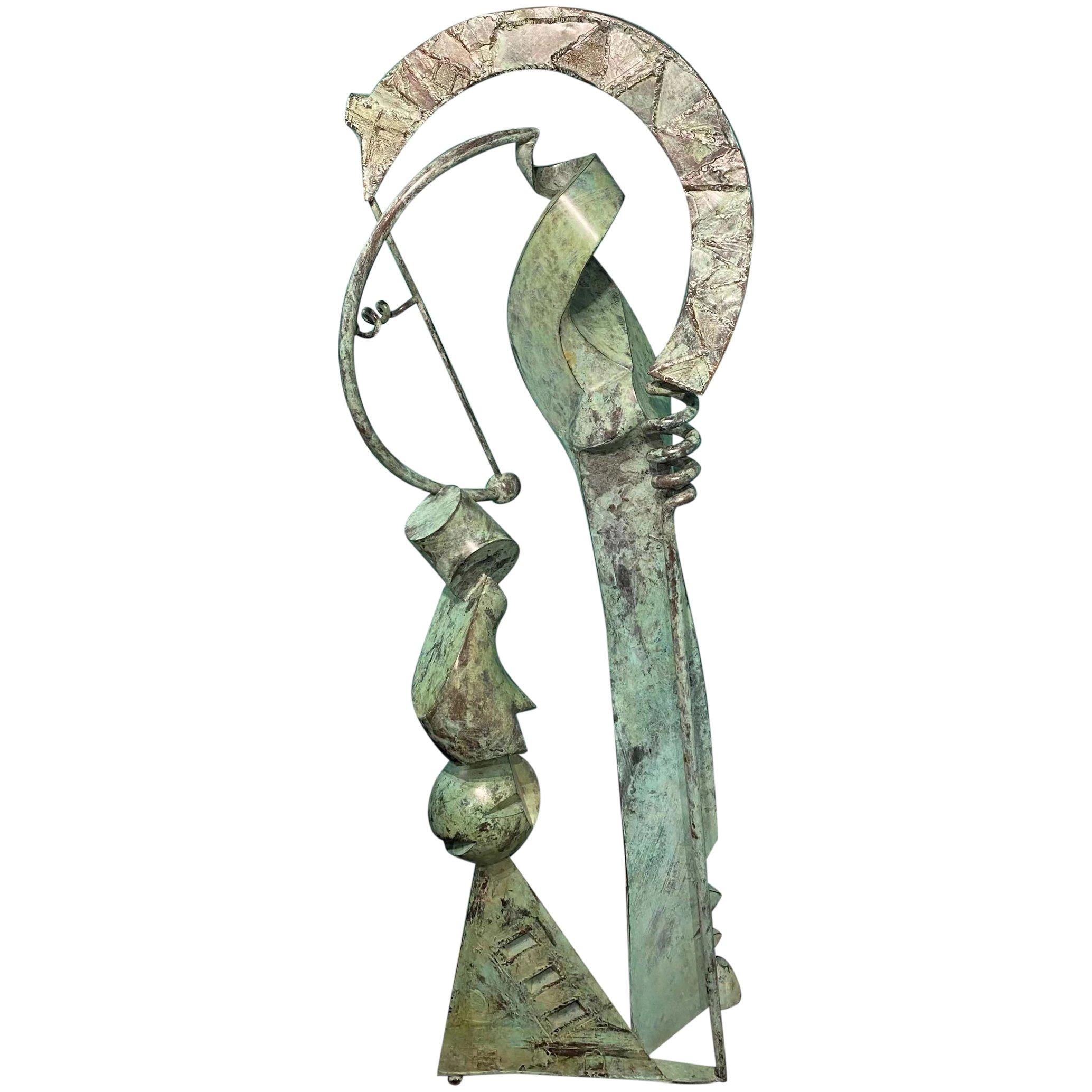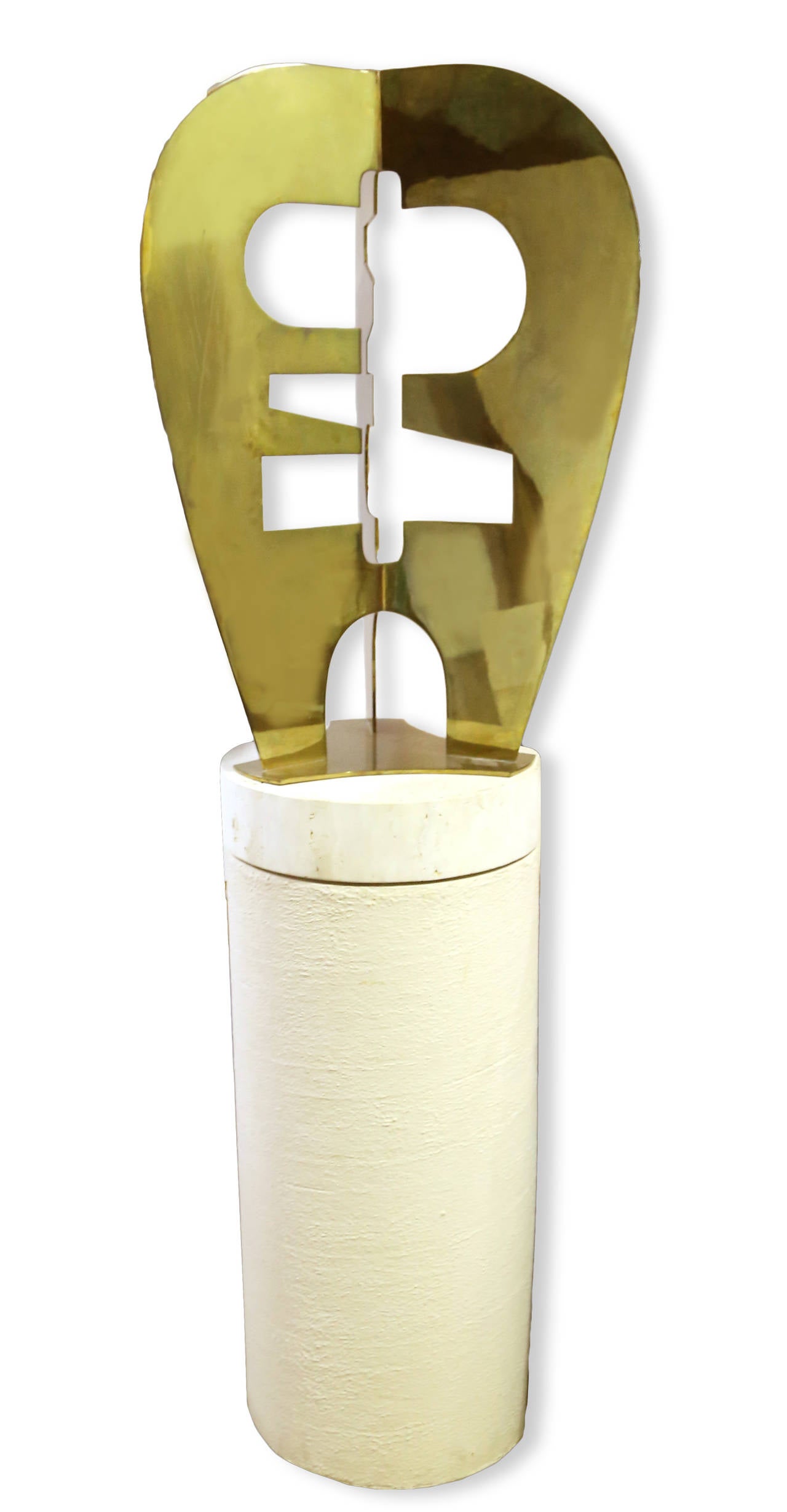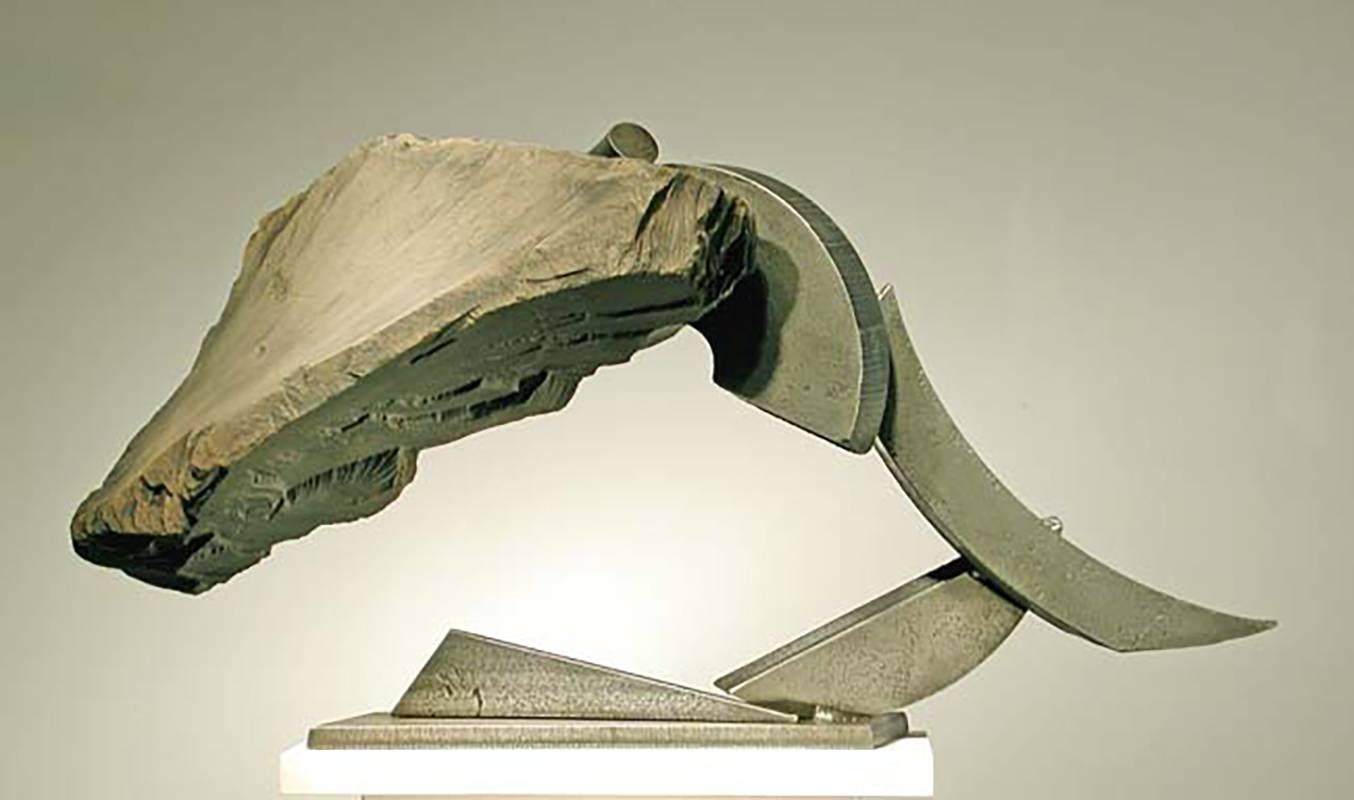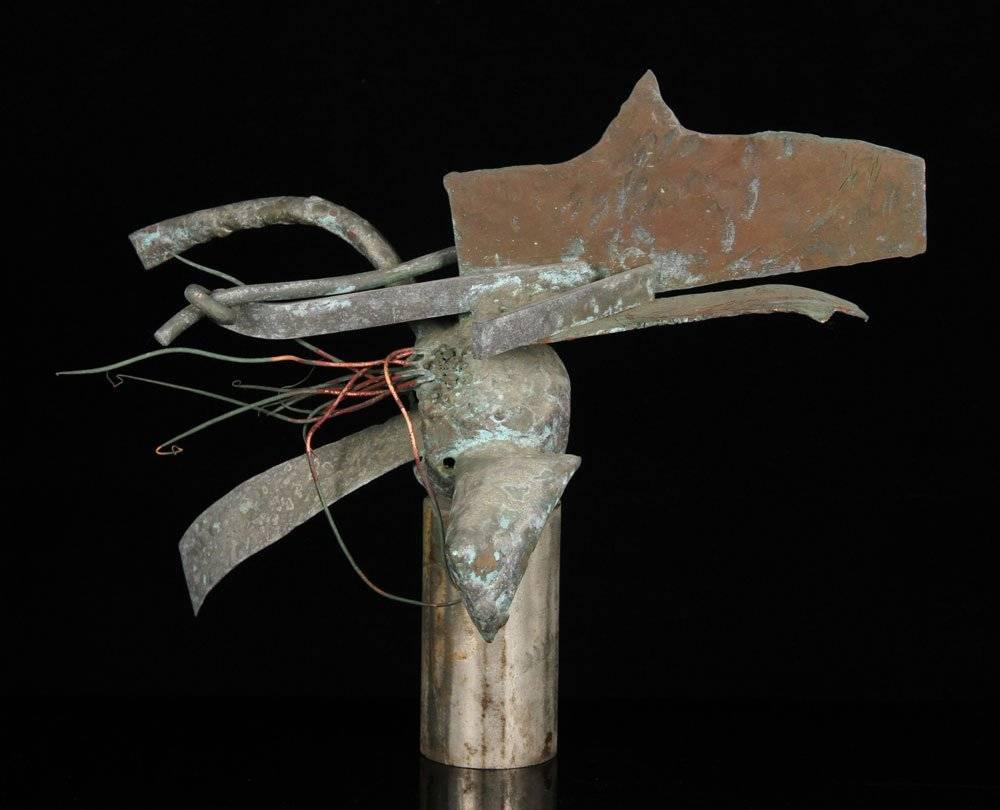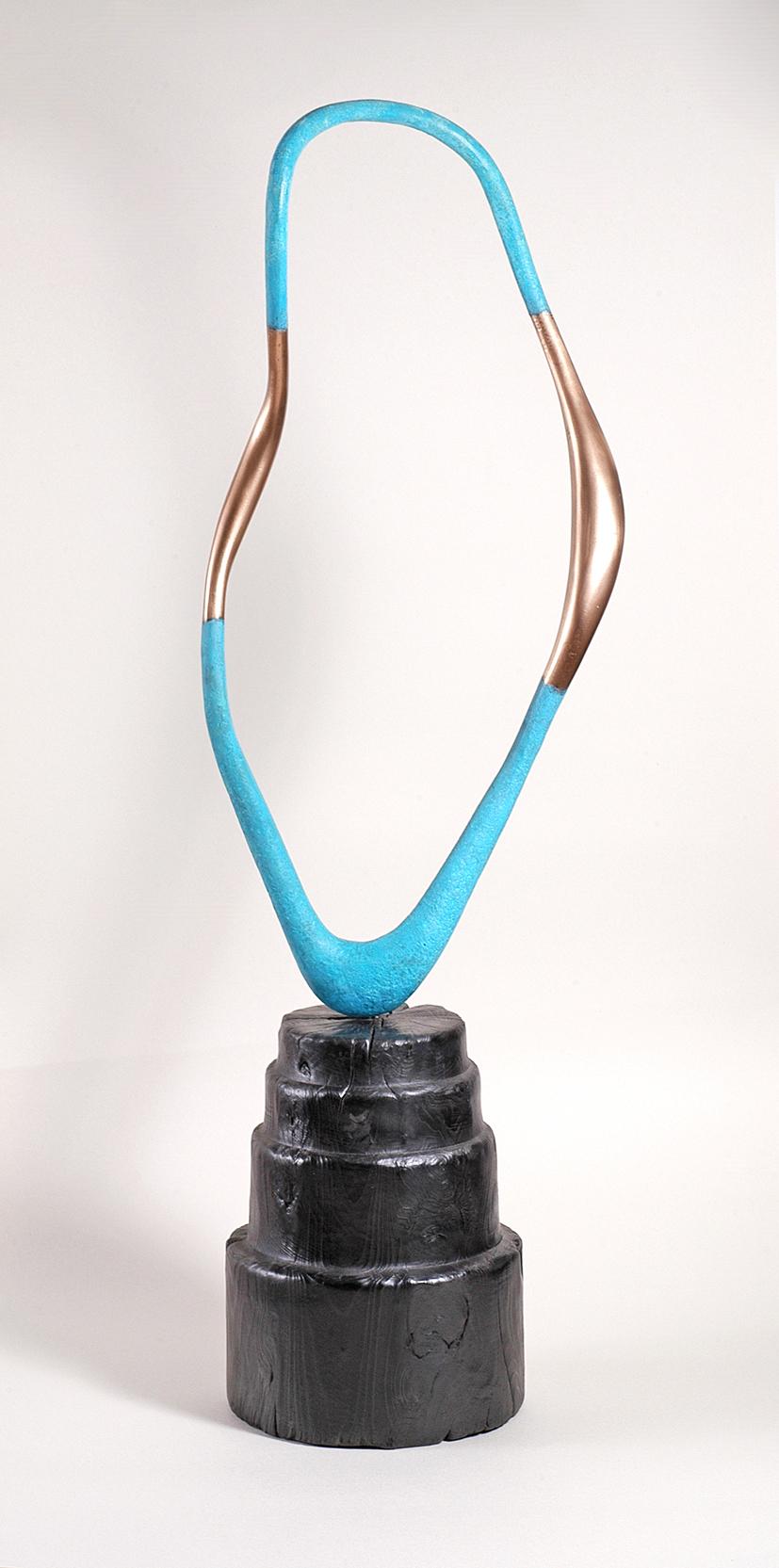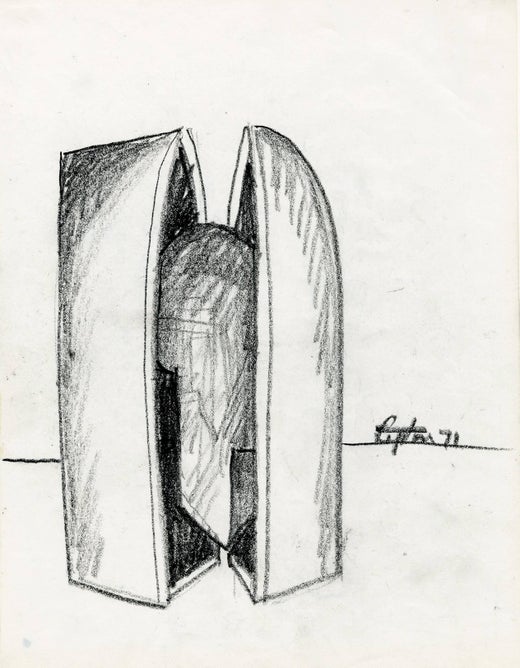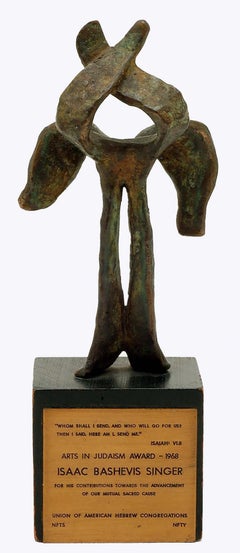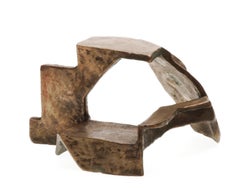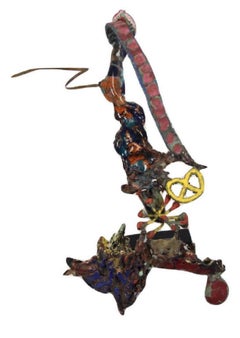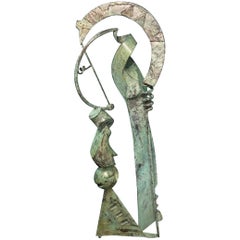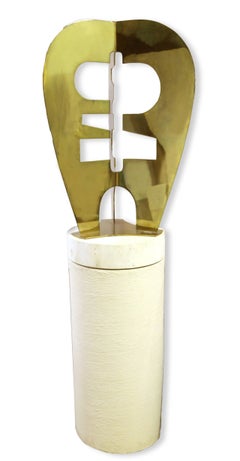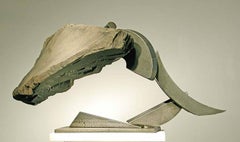Items Similar to Maquette for Laureate (unique sculpture)
Want more images or videos?
Request additional images or videos from the seller
1 of 3
Seymour LiptonMaquette for Laureate (unique sculpture)1968-1969
1968-1969
$88,000
£66,411.18
€76,030.76
CA$124,109.18
A$136,256.40
CHF 71,085.25
MX$1,648,892.10
NOK 890,943.31
SEK 839,502.84
DKK 567,549.34
About the Item
Seymour Lipton
Maquette for Laureate, ca. 1968-1969
Nickel silver on monel metal
Unique
18 × 8 1/2 × 7 inches
Marlborough-Gerson Gallery, New York
Acquired from the above by the previous owner, 1969
thence by descent
Christie's New York: Monday, June 30, 2008 [Lot 00199]
Acquired from the above Christie's sale This unique sculpture by important Abstract Expressionist sculptor Seymour Lipton is a maquette of the monumental sculpture "Laureate" - one of Lipton's most iconic and influential works located on the Riverwalk in downtown Milwaukee, Wisconsin. Laureate is a masterpiece that was commissioned by the Allen-Bradley Company in memory of Harry Lynde Bradley and as an enhancement for the newly constructed Performing Arts Center. It is located on the east bank of the Milwaukee River at 929 North Water Street. The Bradley family in Milwaukee were renowned patrons of modernist sculpture, known for their excellent taste who also founded an eponymous sculpture park. For reference only is an image of the monumental "Laureate" one of Milwaukee's most beloved public sculptures. According to the Smithsonian, which owns a different unique variation of this work, "The full-size sculpture Laureate was commissioned by the Marcus Center for the Performing Arts in Milwaukee. In the initial drawings, Seymour Lipton combined details from the architectural plan with a wide variety of images, ranging from musical instruments to a lighthouse on the island of Tobago. He transformed the basic shapes from these sketches into a welded sculpture, which evokes a figure composed of columns, harp strings, and coiled rope. Lipton created this piece to celebrate achievement in the arts. The dramatic silhouette commands your attention, reflecting the title Laureate, which means worthy of honor and distinction. The final version of the piece is over twelve feet high and stands out against the pale, flat buildings of the arts center.,,"
Provenance
Marlborough-Gerson Gallery, New York
Acquired from the above by the previous owner, 1969
thence by descent
Christie's New York: Monday, June 30, 2008 [Lot 00199]
Acquired from the above Christie's sale
About Seymour Lipton:
Born in New York City in 1903, Seymour Lipton (1903-1986) grew up in a Bronx tenement at a time when much of the borough was still farmland. These rural surroundings enabled Lipton to explore the botanical and animal forms that would later become sources for his work. Lipton’s interest in the dialogue between artistic creation and natural phenomena was nurtured by a supportive family and cultivated through numerous visits to New York’s Museum of Natural History as well as its many botanical gardens and its zoos. In the early 1920s, with the encouragement of his family, Lipton studied electrical engineering at Brooklyn Polytechnic Institute and pursued a liberal arts education at City College. Ultimately, like fellow sculptor Herbert Ferber, Lipton became a dentist, receiving his degree from Columbia University in 1927. In the late 1920s, he began to explore sculpture, creating clay portraits of family members and friends.
In addition to providing him with financial security, dentistry gave Lipton a foundation in working with metal, a material he would later use in his artwork. In the early 1930s, though, Lipton’s primary sculptural medium was wood. Lipton led a comfortable life, but he was also aware of the economic and psychological devastation the Depression had caused New York. In response, he generally worked using direct carving techniques—a form of sculpting where the artist “finds” the sculpture within the wood in the process of carving it and without the use of models and maquettes. The immediacy of this practice enabled Lipton to create a rich, emotional and visual language with which to articulate the desperation of the downtrodden and the unwavering strength of the disenfranchised. In 1935, he exhibited one such early sculpture at the John Reed Club Gallery in New York, and three years later, ACA Gallery mounted Lipton’s first solo show, which featured these social-realist-inspired wooden works. In 1940, this largely self-taught artist began teaching sculpture at the New School for Social Research, a position he held until 1965.
In the 1940s, Lipton began to devote an increasing amount of time to his art, deviating from wood and working with brass, lead, and bronze. Choosing these metals for their visual simplicity, which he believed exemplified the universal heroism of the “everyman,” Lipton could also now explore various forms of abstraction. Lipton’s turn towards increasing abstraction in the 1940s allowed him to fully develop his metaphorical style, which in turn gave him a stronger lexicon for representing the horrors of World War II and questioning the ambiguities of human experience. He began his metal work with cast bronze sculptures, but, in 1946, he started welding sheet metal and lead. Lipton preferred welding because, as direct carving did with wood, this approach allowed “a more direct contact with the metal.”[ii] From this, Lipton developed the technique he would use for the remainder of his career: “He cut sheet metal, manipulated it to the desired shapes, then joined, soldered, or welded the pieces together. Next, he brazed a metal coating to the outside to produce a uniform texture.”[iii]
In 1950, Lipton arrived at his mature style of brazing on Monel metal. He also began to draw extensively, exploring the automatism that abstract expressionist painters were boasting at the time. Like contemporaries such as Jackson Pollock, Lipton was strongly influenced by Carl Jung’s work on the unconscious mind and the regenerative forces of nature. He translated these two-dimensional drawings into three-dimensional maquettes that enabled him to revise his ideas before creating the final sculpture.The forms that Lipton produced during this period were often zoomorphic, exemplifying the tension between the souls of nature and the automatism of the machine.
In the years following the 1950s, Lipton’s optimism began to rise, and the size of his work grew in proportion. The oxyacetylene torch—invented during the Second World War—allowed him to rework the surfaces of metal sculptures, thus eliminating some of the risks involved with producing large-scale finished works. In 1958, Lipton was awarded a solo exhibition at the Venice Biennale and was thus internationally recognized as part of a small group of highly regarded avant-garde constructivist sculptors. In 1960, he received a prestigious Guggenheim Award, which was followed by several prominent public commissions, including his heroic Archangel, currently residing in Lincoln Center’s David Geffen Hall.
A number of important solo exhibitions of his work followed at The Phillips Collection in Washington, DC (1964); the Milwaukee Art Center and University of Wisconsin, Milwaukee (1969); the Virginia Museum of Fine Arts in Richmond (1972); the Everson Museum in Syracuse, NY (1973); the Herbert E. Johnson Museum of Art of Cornell University in Ithaca, NY (1973); the National Collection of Fine Arts, Smithsonian Institution (now the Smithsonian American Art Museum) in Washington, DC (1978); and a retrospective in 1979 at The Jewish Museum in New York. In 1982 and 1984 alone, two exhibitions of his sculpture, organized respectively by the Mint Museum (Charlotte, NC) and the Hillwood Art Gallery of Long Island University (Greenvale, NY), traveled extensively across museums and university galleries around the nation. In 2000, the traveling exhibition An American Sculptor: Seymour Lipton was first presented by the Palmer Museum of Art of Pennsylvania State University in University Park. Most recently, in 2009, the Ackland Art Museum in Chapel Hill, NC mounted The Guardian and the Avant-Garde: Seymour Lipton’s Sentinel II in Context.
Since 2004, Michael Rosenfeld Gallery has been the exclusive representative of the Estate of Seymour Lipton and has presented two solo exhibitions of his work—Seymour Lipton: Abstract Expressionist Sculptor (2005) and Seymour Lipton: Metal (2008). In 2013, Michael Rosenfeld Gallery presented Abstract Expressionism, In Context: Seymour Lipton, which included twelve major sculptures by the artist, along with works by Charles Alston, Norman Bluhm, Beauford Delaney, Willem de Kooning, Jay DeFeo, Michael Goldberg, Adolph Gottlieb, Hans Hofmann, Lee Krasner, Norman Lewis, Conrad Marca-Relli, Boris Margo, Alfonso Ossorio, Richard Pousette-Dart, Milton Resnick, Charles Seliger, Alma Thomas, Mark Tobey, Jack Tworkov and Hale Woodruff.
Other notable group exhibitions in recent years include: Abstract Expressionist New York at the Museum of Modern Art in New York (2010); Encounters with the 1930s at the Museo Nacional Centro de Arte Reina Sofía in Madrid, Spain (2012); Its Surreal Thing: The Temptation of Objects at the Sheldon Museum of Art, University of Nebraska in Lincoln (2013); Abstraction: Drawings by Sculptors at The Metropolitan Museum of Art in New York (2015) and Marvelous Objects: Surrealist Sculpture from Paris to New York at the Hirshhorn Museum and Sculpture Garden in Washington, DC (2015). In 2018, the Art Gallery of Ontario in Toronto included Lipton’s work in the reinstallation of their permanent collection, Look:Forward.
Seymour Lipton’s works are in numerous museum collections worldwide including the Albright-Knox Art Gallery, Buffalo, NY; Arkansas Art Center, Little Rock, AR; Art Gallery of Ontario, Toronto, Canada; Baltimore Museum of Art, Baltimore, MD; Brooklyn Museum of Art, Brooklyn, NY; Cantor Art Center, Stanford University, Palo Alto, CA; Cleveland Museum of Art, Cleveland, OH; Columbus Museum of Art, Columbus, OH; Corcoran Museum of Art, Washington, DC; Crystal Bridges Museum of Art, Bentonville, AR; Dallas Museum of Art, Dallas, TX; Delaware Art Museum, Wilmington, DE; Denver Art Museum, Denver, CO; Des Moines Art Center, Des Moines, IA; Detroit Institute of Arts, Detroit, MI; Didrichsen Museum, Helsinki, Finland; Governor Nelson A. Rockefeller Empire State Plaza Art Collection, Albany, NY; Grey Art Gallery, New York University, New York, NY; Hammer Art Museum, Los Angeles, CA; Herbert F. Johnson Museum of Art, Cornell University, Ithaca, NY; Hillwood Art Museum, Long Island University, Brookville, NY; Hirshhorn Museum and Sculpture Garden, Smithsonian Institution, Washington, DC; The Jewish Museum, New York, NY; The Metropolitan Museum of Art, New York, NY; The Mint Museum of Art, Charlotte, NC; Mobile Museum of Art, Mobile, AL; Museum of Art, Rhode Island School of Design, Providence, RI; Museum of Fine Arts, Boston, MA; The Museum of Modern Art, New York, NY; The Nelson-Atkins Museum of Art, Kansas City, MO; National Gallery of Art, Washington, DC; Neuberger Museum of Art, Purchase College, State University of New York, Purchase, NY; New Britain Museum of Art, New Britain, CT; New Orleans Museum of Art, New Orleans, LA; Newark Museum, Newark, NJ; Oklahoma City Museum of Art, Oklahoma City, OK; Pennsylvania Academy of Fine Arts, Philadelphia, PA; Philadelphia Museum of Art, Philadelphia, PA; The Phillips Collection, Washington, DC; Phoenix Art Museum, Phoenix, AZ; Portland Art Museum, Portland, OR; San Diego Museum of Art, San Diego, CA; San Francisco Museum of Modern Art, San Francisco, CA; San José Museum of Art, San José, CA; Santa Barbara Museum, Santa Barbara, CA; São Paulo Museum, São Paulo, Brazil; Smithsonian American Art Museum, Washington, DC; Tamayo Museum, Mexico City, Mexico; Tel Aviv Museum, Tel Aviv, Israel; Tucson Museum of Art, Tucson, AZ; Virginia Museum of Fine Art, Richmond, VA; Wadsworth Atheneum Museum of Art, Hartford, CT; Whitney Museum of American Art, New York, NY; Wichita Art Museum, Wichita, KS; and Yale University Art Gallery, New Haven, CT.
- Courtesy of Micheal Rosenfeld
- Creator:Seymour Lipton (1903 - 1986, American)
- Creation Year:1968-1969
- Dimensions:Height: 18 in (45.72 cm)Width: 8.5 in (21.59 cm)Depth: 7 in (17.78 cm)
- Medium:
- Movement & Style:
- Period:
- Condition:
- Gallery Location:New York, NY
- Reference Number:1stDibs: LU1745214379432
Seymour Lipton
Seymour Lipton was an American abstract expressionist sculptor. He was a member of the New York School who gained widespread recognition in the 1950s. His early choices of medium changed from wood to lead and then to bronze, and he is best known for his work in metal. He made several technical innovations, including brazing nickel-silver rods onto sheets of Monel to create rust resistant forms. Through the medium of metal sculpture, Lipton endeavored to portray the inner complexities of the human psyche through shapes that enclose and oppose each other, interrelating convex and concave, solid and hollowed forms. Although his imagery was often based on visual stimuli, his expressive abstractions were never literal translations of the visible world. He altered and arranged shapes to create sculptures symbolizing intangible, universal concepts absorbed from sociology, psychology, and myth.
About the Seller
5.0
Platinum Seller
Premium sellers with a 4.7+ rating and 24-hour response times
Established in 2007
1stDibs seller since 2022
451 sales on 1stDibs
Typical response time: 2 hours
- ShippingRetrieving quote...Shipping from: New York, NY
- Return Policy
Authenticity Guarantee
In the unlikely event there’s an issue with an item’s authenticity, contact us within 1 year for a full refund. DetailsMoney-Back Guarantee
If your item is not as described, is damaged in transit, or does not arrive, contact us within 7 days for a full refund. Details24-Hour Cancellation
You have a 24-hour grace period in which to reconsider your purchase, with no questions asked.Vetted Professional Sellers
Our world-class sellers must adhere to strict standards for service and quality, maintaining the integrity of our listings.Price-Match Guarantee
If you find that a seller listed the same item for a lower price elsewhere, we’ll match it.Trusted Global Delivery
Our best-in-class carrier network provides specialized shipping options worldwide, including custom delivery.More From This Seller
View AllBronze Sculpture to Isaac Bashevis Singer, Arts in Judaism Award signed Judaica
By Nathaniel Kaz
Located in New York, NY
Nathaniel Kaz
Bronze Sculpture to Isaac Bashevis Singer for Arts in Judaism Award, 1966
Bronze, Square wooden base, Metal tag
Signed and dated "66" to back of bronze portion of the w...
Category
1960s Abstract Expressionist Abstract Sculptures
Materials
Metal, Bronze
Abstract Bronze Sculpture, Unique Signed work from the estate of Arthur Carr
By Peter Reginato
Located in New York, NY
Peter Reginato
Abstract Bronze Sculpture, ca. 1987
Bronze
Signed on the underside
4 × 6 1/2 × 5 1/2 inches
This bronze sculpture is by the American abstract sculptor Peter Reginato. ...
Category
1980s Abstract Abstract Sculptures
Materials
Bronze
Untitled signed sculpture, from the collection of Dick Polich, Tallix Foundry
By Stephen Talasnik
Located in New York, NY
Stephen Talasnik
Untitled sculpture, from the collection of Dick Polich, Tallix Foundry, ca. 1997
Cast light metal
signed by the artist on the work (see close up photograph)
6 3/5 × 12 × 4 inches
Provenance
Estate of Dick Polich, founder of the legendary Tallix Foundry and Polich Art works Beacon, NY
Manufacturer
Stephen Talasnik at Tallix Foundry, Beacon, New York
This work is signed by the artist (see close up photograh)
Abstract metal sculpture
The work is lightweight so it is believed to be in aluminum or an aluminum alloy,
Provenance: acquired from the Estate of Dick Polich - founder of the legendary Tallix foundry and Polich Art Works.
Polich and Tallix fabricated significant sculptural works over many years, collaborating with such as, Willem de Kooning, Jeff Koons, Roy Lichtenstein, Frank Stella, Helen Frankenthaler, ERTE, Julian Schnabel, Richard Artschwager, Isamu Noguchi, Isaac Witkin...
Category
1990s Abstract Expressionist Abstract Sculptures
Materials
Metal
Famed sculptor Nancy Graves unique signed patinated bronze sculpture NY Award
By Nancy Graves
Located in New York, NY
Nancy Graves
New York State Governor's Arts Award, 1988
Bronze, polychrome patina and baked enamel on base with Award plaque
10 1/4 × 7 × 10 1/4 inches
Hand signed and dated with inc...
Category
1980s Abstract Expressionist Abstract Sculptures
Materials
Enamel, Bronze
Uxmal, unique bronze sculpture by Greek-American sculptor and Harvard professor
Located in New York, NY
Dimitri Hadzi
Uxmal, 1991
Cast bronze on custom made granite base
17 × 30 1/2 × 14 inches
The title UXMAL, refers to the ancient Mayan city of Uxmal, which is known for its "Pyramid of the Magician"
Provenance:
Acquired by the original owner from the prestigious Gremillion Gallery in Houston, Texas (accompanied by a copy of the original receipt)
Measurements:
Base:
26.5 by 11 by 1.75 inches
Work longest
30.5 inches
Widest 14 inches
Highest. 17 inches
More about Dimitri Hadzi"
Derived from the figure and mythic narratives, Hadzi’s sculpture references antiquity and classical artifacts – abstracted anatomical forms, columnar and other architectural elements, helmets, weaponry and body armor function as visual metaphors for ancient cultures. “I was interested in mythology, and I was interested in movement,” Hadzi remarked on his years in Rome, “I was attempting through formal methods to exaggerate sexual tension or apprehension. Suddenly I was myself in an atmosphere of freedom.” [1] Powerfully rendered in bronze his sculptures convey raw emotion, brute strength and mass, tempered with a delicate rush of whimsy, vivacity and sensuality.
Born in New York City on March 21, 1921, Hadzi graduated from Cooper Union in 1950 and received a Fulbright Fellowship in the same year. After studying sculpture in Greece, he moved to Rome under the GI Bill where he lived for twenty-five years. Hadzi returned to the U.S. where he taught at Harvard University for fourteen years. He continued to create sculpture until his death in 2006.
Hadzi is included in the permanent collections of the Museum of Modern Art; the Whitney Museum of American Art; the Museum of Fine Arts, Boston; the Hirshhorn Museum and Sculpture Garden; The Phillips Collection and the Guggenheim Museum. Receiving over twenty sculpture commissions, Hadzi’s work appears in public squares, concert halls, federal and private plazas, and universities throughout the world.
---------------
[1] Elsen, Albert. “On Artistic Freedom: An Interview,” Dimitri Hadzi, (New York: Hudson Hills Press, 1996), 30.
Additional Biography:
Dimitri Hadzi (1921 – 2006) is among the most distinguished modernist sculptors, creator of works in bronze and stone that are powerfully abstract and expressionist in character. His contribution to the international language of sculpture continues to influence and inspire through permanent installations and collections, and exhibitions worldwide.
Born to Greek-American immigrant parents in New York City, he had a talent for drawing at an early age and won a prize for his young ability. But, it wasn't until after serving in the Air-force in the South Pacific during WWII that he turned his sights fully to painting and sculpture, going on to study both at Cooper Union. Eventually, he would become a mainstay of the Cambridge, MA art community. He was a Guggenheim Fellow (1957), the winner of the Venice Biennale Award (1962), and the Rome Prize (1974).
His most notable sculptures are: Copley Place Waterfall (Boston, MA), Owen Glass Co. (Toledo, OH), as well as Thermopolis, adjacent to Boston’s City Hall Plaza, and the former Omphalos in Harvard Square (Cambridge, MA).
Hadzi is included in the permanent collections of the Museum of Modern Art; National Gallery of Art; Whitney Museum of American Art; Museum of Fine Art, Boston; Hirshhorn Museum and Sculpture Garden; The Phillips Collection and the Guggenheim Museum.
Additionally, Hadzi was also a prolific painter, and printmaker. He also taught at Harvard University for over a decade. Famously, David Hockney attended one of Hadzi’s classes at the Carpenter Center at Harvard, where Hadzi served as director. The two of them spent time together painting and discussing techniques. Hockney gifted Hadzi one of his paintings.
He worked alongside his good friend, Nobel Prize winning Irish poet...
Category
1990s Abstract Abstract Sculptures
Materials
Granite, Bronze
Bruce # 9
By Ray Geary
Located in New York, NY
Ray Geary
Bruce #9, 2016
Steel
Incised signature, title and date on the underside
10 x 7 inches
Bruce # 9 is one of ten unique sculptures that popular young sculptor Ray Geary made exclusively for the Whitney Museum. Below is how the Museum described the series:
These fanciful totemic objects, lovingly named Bruce, are made of steel purchased from a scrap metal yard in the Meatpacking District...
Category
2010s Abstract Abstract Sculptures
Materials
Steel
$1,500
You May Also Like
Modernist Abstract Sculpture
Located in Milford, NH
A wonderful large modernist abstract bronze sculpture with geometric shapes by American artist Rodger Allen Mack (1938-2002). Mack was born in Barberton, Ohio, graduated from the Cle...
Category
20th Century Abstract Expressionist Abstract Sculptures
Materials
Bronze
Untitled Bronze Sculpture
By Henry Moretti
Located in Long Island City, NY
Artist: Henry Moretti, French/American
Title: Untitled
Medium: Bronze Sculpture
Size: 35 x 24 x 23 in. (88.9 x 60.96 x 58.42 cm)
Base: 37 x 17 x 17 inches
Category
20th Century Contemporary Abstract Sculptures
Materials
Bronze
Untitled abstract expressionist mid-century modern sculpture
By Thomas Morin
Located in Wilton Manors, FL
Thomas Morin (1934-2017)
Untitled, 1962.
Cast iron on wood base. Cast sculpture measures 24 x 7 x 5 inches and weighs 49 lbs. Overall measures 26 inches tall on wood base.
Proc...
Category
Mid-20th Century Abstract Expressionist Abstract Sculptures
Materials
Iron
$2,400 Sale Price
40% Off
John Van Alstine - FLECHE, Sculpture 2005
By John Van Alstine
Located in Greenwich, CT
Slate, Steel
Stone and metal, usually granite or slate and found object steel are central in my sculpture. The interaction of these materials is a major focus. On the most basic lev...
Category
Early 2000s Abstract Abstract Sculptures
Materials
Stone, Slate, Steel, Cut Steel, Stainless Steel
Brutalist Bronze Abstract Modernist Sculpture
Located in Surfside, FL
In the manner of Julio Gonzalez, mixed metal sculpture.
Neo-Dada Abstract Sculpture: Assemblages
Abstract sculpture followed a slightly different course. Rather than focusing on non-figurative subject matter, it concentrated on materials, hence the emergence of Assemblage Art - a form of three-dimensional visual art made from everyday objects, said to be 'found' by the artist (objets trouves). Popular in the 1950s and 1960s in America, assemblage effectively bridged the gap between collage and sculpture, while its use of non-art materials - a feature of Neo-Dada art - anticipated the use of mass-produced objects in Pop-Art. Assemblage sculpture is exemplified by the works of Louise Nevelson (1899-1988), such as Mirror Image 1 (1969, Museum of Fine Arts, Houston), and by Jean Dubuffet (1901-85) and his Monument with Standing Beast (1960, James R. Thompson Center, Chicago). The idiom was considerably boosted by an important exhibition - "The Art of Assemblage" - at the Museum of Modern Art, in New York, in 1961.
Other examples of the Neo-Dadaist-style "junk art...
Category
20th Century Abstract Expressionist Abstract Sculptures
Materials
Bronze, Copper
British Contemporary Sculpture by Philip Hearsey - Acanto IV
By Philip Hearsey
Located in Paris, IDF
Year 2016
73 x 26 high x 18 cm
Bronze freely rotating on a scorched yew base.
Series of individual variations
Stamped with monogram signature and uniquely numbered 619A
Parts of th...
Category
2010s Contemporary Abstract Sculptures
Materials
Bronze
More Ways To Browse
Cast Metal Sculpture
Large Brass And Wood Sculptures
Sculpture Maquette
Maquettes For Sculptures
Sculpture Of Family
Michael Jay
Nesting Bowl
Peter Mandala
Plinths Outdoor
Porcelain Edmund De Waal
Robert Longhurst
Rosenthal Louise
Salvador Dali Menorah
Sergio Bautista De La Cruz
Spoon Chandelier
Tammy Garcia
Vasarely Zebra Sculpture
Wendy Froud
